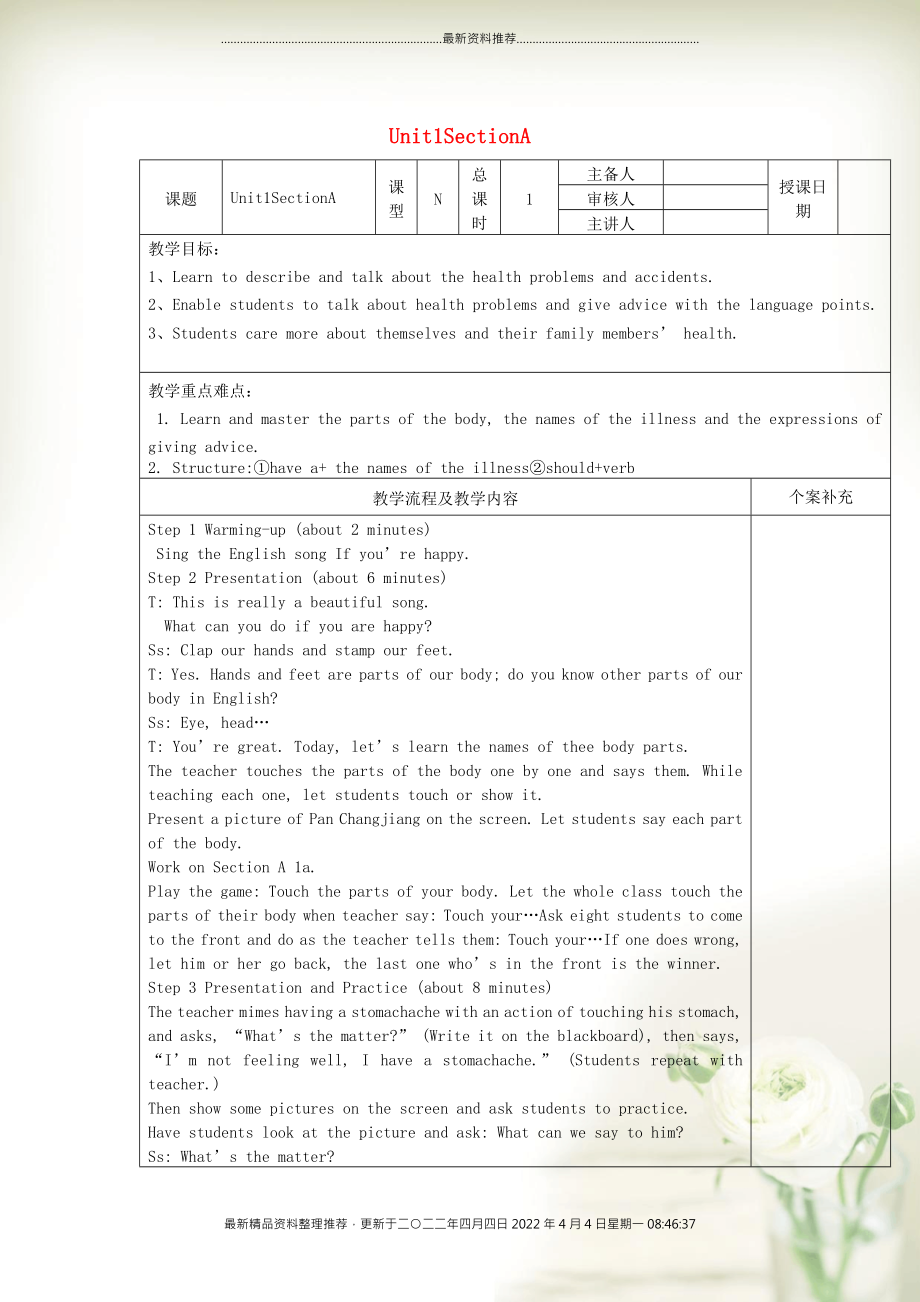《八年級英語下冊《Unit1 What’t the matter》(第一課時(shí))教案 (新版)人教新目標(biāo)版》由會員分享,可在線閱讀���,更多相關(guān)《八年級英語下冊《Unit1 What’t the matter》(第一課時(shí))教案 (新版)人教新目標(biāo)版(3頁珍藏版)》請?jiān)谘b配圖網(wǎng)上搜索��。
1���、……………………………………………………………最新資料推薦…………………………………………………
Unit1SectionA
課題
Unit1SectionA
課型
N
總課時(shí)
1
主備人
授課日期
審核人
主講人
教學(xué)目標(biāo):
1、Learn to describe and talk about the health problems and accidents.
2��、Enable students to talk about health problems and give advice with the language points.
2、3����、Students care more about themselves and their family members’ health.
教學(xué)重點(diǎn)難點(diǎn):
1. Learn and master the parts of the body, the names of the illness and the expressions of giving advice.
2. Structure:①have a+ the names of the illness②should+verb
教學(xué)流程及教學(xué)內(nèi)容
個(gè)案補(bǔ)充
Step 1 Warming-up (about 2 minut
3、es)
Sing the English song If you’re happy.
Step 2 Presentation (about 6 minutes)
T: This is really a beautiful song.
What can you do if you are happy?
Ss: Clap our hands and stamp our feet.
T: Yes. Hands and feet are parts of our body; do you know other parts of our body in English?
Ss:
4��、Eye, head…
T: You’re great. Today, let’s learn the names of thee body parts.
The teacher touches the parts of the body one by one and says them. While teaching each one, let students touch or show it.
Present a picture of Pan Changjiang on the screen. Let students say each part of the body.
Work
5���、 on Section A 1a.
Play the game: Touch the parts of your body. Let the whole class touch the parts of their body when teacher say: Touch your…Ask eight students to come to the front and do as the teacher tells them: Touch your…If one does wrong, let him or her go back, the last one who’s in the fro
6���、nt is the winner.
Step 3 Presentation and Practice (about 8 minutes)
The teacher mimes having a stomachache with an action of touching his stomach, and asks, “What’s the matter?” (Write it on the blackboard), then says, “I’m not feeling well, I have a stomachache.” (Students repeat with teacher.)
7、
Then show some pictures on the screen and ask students to practice.
Have students look at the picture and ask: What can we say to him?
Ss: What’s the matter?
T: Yes. And what should the boy say?
Let students repeat with other pictures about other illness.
Ask some students to use gestures to s
8����、how the illness, and have others to guess.
Make a model dialogue. (S1 does an action to express an illness.)
T: What’s the matter with him ?
Ss: He has a headache.
Let students practice other illness.
A: What’s the matter?
B: He/ She has a headache/ toothache/ a sore back/ a sore throat/ a col
9、d and a cough.
Show other pictures, and ask students to talk about health problems of the persons in the pictures in pairs.
Step 4 Listen and Say (about 8 minutes)
Work on Section A 1b, listen and number the names [1-5].
Have students work in pairs according to 1c and ask some pairs to act out t
10��、heir conversations.
Step 5 Presentation (about 5 minutes)
Work in groups, and have students role-play between a doctor and a patient. Ask them to talk about the health problems and give advice in groups.
Step 6 Practice (about 7 minutes)
Do 2a. Have students listen and number the picture [1-5]i
11����、n the order they hear. Then check the answer. Play the tape again for the students and let them do 2b by themselves.
Have students listen again and match the problems with the advice. Then play it again and check the answers.
Do 2c. Pair work. Let students read the conversations in 2c first. Then
12�����、work in pairs, make a new conversation according to 2a and 2b.
Step 7 Expansion and Extension (about 5 minutes)
Role-play the conversation.
First, have students to role-play the conversation in 2d in groups and choose the best.
In groups, students discuss the language points and solve the probl
13、ems. The teacher walks around and gives them some help if they need.
Step 8 Summary (about 3 minutes)
Ask students to sum up the parts of a body and the names of illness.
Help students to sum up how to give advice by using “should” and “shouldn’t”, then ask them to give the right advice about dif
14�����、ferent problems.
作業(yè)設(shè)計(jì):
Give advice to the following problems as much as possible: sore throat, toothache, headache, cold. Then choose one to make a dialogue with your partner.
板書設(shè)計(jì):
Unit 1 What’s the matter?
What’s the matter? I have a stomachache/ sore throat/ a cold.
What’s the matter with her /him ?She/ He has a very sore throat.
What should I/he/she do? You should/ shouldn’t…
教學(xué)反思:
最新精品資料整理推薦���,更新于二〇二二年四月四日2022年4月4日星期一08:46:37
 八年級英語下冊《Unit1 What’t the matter》(第一課時(shí))教案 (新版)人教新目標(biāo)版
八年級英語下冊《Unit1 What’t the matter》(第一課時(shí))教案 (新版)人教新目標(biāo)版

